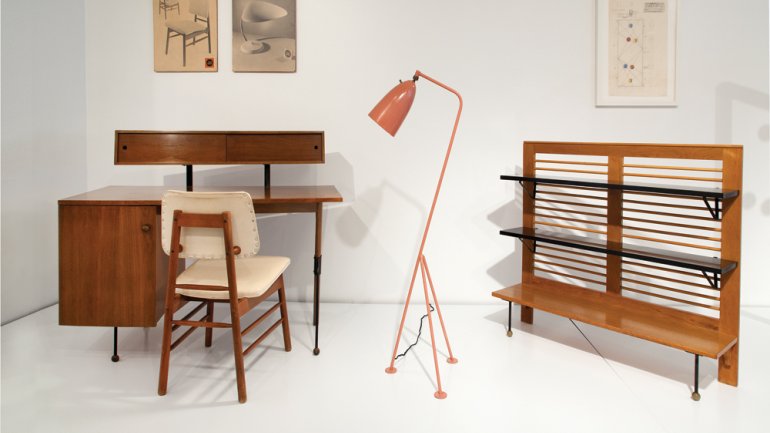Market Makers
Market Makers
R & Company
82 Franklin St.
New York, NY 10013
(212) 343-7979
Zesty Meyers and Evan Snyderman met as 20-something glassblowers in New York in the mid-1990s. Meyers was the founder of the B Team, a troupe of artists bent on pushing the boundaries of glass beyond object making into the realm of performance art. Snyderman, the son of veteran craft dealers Ruth and Rick Snyderman, grew up in his parents’ Philadelphia galleries, steeped in art and the business of it. Besides glass, the two young men shared an interest in vintage modern design. They began selling items at a flea market, quickly generated enough business (and buzz) to open their R 20th Century gallery in Brooklyn’s Williamsburg neighborhood in 1997, and in 2000 moved it to Manhattan’s Tribeca neighborhood. In January they changed the name to R & Company.
Now seasoned dealers in their 40s, Snyderman and Meyers won’t tell what the “R” stands for. (“That’s a secret,” says Meyers.) But they love to talk about the work they present – innovative, finely crafted furniture and objects by 20th-century and now, contemporary designers – and their commitment to nurturing the newly hot market for “collectible design.”
You started getting serious as dealers, with an initial focus on vintage design, around 1997.
Meyers: We were shipping containers back from Europe at that point, which no one else was really doing for midcentury work. Back then we didn’t have internet, so we had these intellectual discussions: “Charles Eames and Jean Prouvé were so famous, but there must be others out there.” We started to build our antiquarian library, to sort of search the world for great design. We would read something, and get on a plane.
Snyderman: We’d fly to Holland, rent a van, and drive into Belgium, France, and back. We’d find all these designs by names we hadn’t really heard. Then we’d come back to New York, pull out books, and find these designers. We’d be like, “Oh, wow, here they are. Why hasn’t anyone ever sold this stuff here?” So we’d start to show people: “Look, here’s the proof, this was really important in Holland in 1957, and this is why.” And people started to listen. So all of a sudden, we had a bit of an angle that was different from other design shops. We decided if we were going to set ourselves apart, do this seriously, then we needed to up the ante, make it a little more interesting. We wanted to create exhibitions, create a market, do something beyond what everyone else was doing.
What’s the common thread among the designers you represent?
Snyderman: We currently represent about 10 people, and although they are all radically different in how they approach their work and run their businesses, they are all working in a similar fashion, which is that they are deeply connected to the process and the making. The idea goes beyond just making another object.
Meyers: They might be master craftsmen, but it doesn’t end with how beautifully something is made. It has to have an idea behind it, a concept, some longer, larger life or place in the world.
Tell us about a few of the artists you’ve brought to the fore.
Snyderman: In terms of historical designers, Greta Magnusson Grossman [1906-1999] is the obvious one. When we started to talk about Greta and collect her work, no one had really heard of her. We invested almost 10 years of our time and energy in building the huge market that now exists for Greta. We also own her estate. We published a book, created a museum show. There’s even work in production again, being sold at Design Within Reach.
Meyers: We gave [Brazilian modernist furniture designer] Sergio Rodrigues his first solo North American show. He’s still alive, and now has this huge global presence, and they’re putting his furniture back into production. Every one of the people we could talk about would have a story like this.
How would you describe this moment in time, for design?
Snyderman: What we call collectible design now is a new market, and literally 10 years ago is when it started to take shape. We’re talking about objects created with a bigger purpose, an idea that they find a home with a collector, or someone who understands that the value of the work goes beyond the function. Yes, it’s furniture, but it now has a higher purpose.
All of this really started with the introduction of the design fairs. Design Miami was the first time that the art collector entered the arena of collecting design more publicly. There have always been people who collect furniture, yes, but this is a new thing, a massive market where doors have opened for the contemporary art collector to see design in a new light. Collectors have always been able to buy another painting, whether or not they need it. This is our battle as a gallery: We are selling objects that have a function – that fit into a home – and how do you get beyond that? The idea of a greater value is a very new concept. And we feel like we’ve only just scratched the surface. This market is going to continue to grow.
Meyers: Hugely.
Joyce Lovelace is American Craft’s contributing editor.




